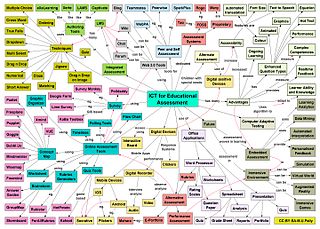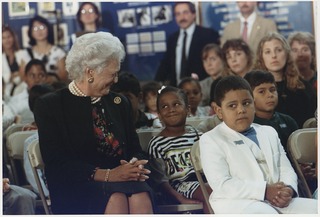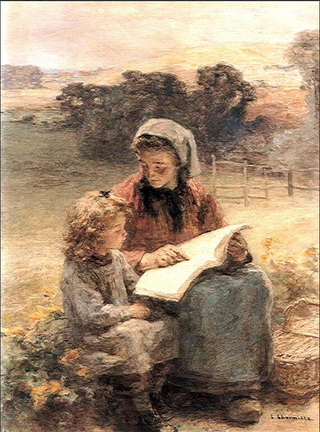Related Research Articles

Literacy in its broadest sense describes "particular ways of thinking about and doing reading and writing" with the purpose of understanding or expressing thoughts or ideas in written form in some specific context of use. In other words, humans in literate societies have sets of practices for producing and consuming writing, and they also have beliefs about these practices. Reading, in this view, is always reading something for some purpose; writing is always writing something for someone for some particular ends. Beliefs about reading and writing and its value for society and for the individual always influence the ways literacy is taught, learned, and practiced over the lifespan.
The Association of College and Research Libraries defines information literacy as a "set of integrated abilities encompassing the reflective discovery of information, the understanding of how information is produced and valued and the use of information in creating new knowledge and participating ethically in communities of learning."
Minimally invasive education (MIE) is a form of learning in which children operate in unsupervised environments. The methodology arose from an experiment done by Sugata Mitra while at NIIT in 1999, often called The Hole in the Wall, which has since gone on to become a significant project with the formation of Hole in the Wall Education Limited (HiWEL), a cooperative effort between NIIT and the International Finance Corporation, employed in some 300 'learning stations', covering some 300,000 children in India and several African countries.

Information and communications technology (ICT) is an extensional term for information technology (IT) that stresses the role of unified communications and the integration of telecommunications and computers, as well as necessary enterprise software, middleware, storage and audiovisual, that enable users to access, store, transmit, understand and manipulate information.

Reading for special needs has become an area of interest as the understanding of reading has improved. Teaching children with special needs how to read was not historically pursued due to perspectives of a Reading Readiness model. This model assumes that a reader must learn to read in a hierarchical manner such that one skill must be mastered before learning the next skill. This approach often led to teaching sub-skills of reading in a decontextualized manner. This style of teaching made it difficult for children to master these early skills, and as a result, did not advance to more advanced literacy instruction and often continued to receive age-inappropriate instruction.
Critical literacy is the ability to find embedded discrimination in media. This is done by analyzing the messages promoting prejudiced power relationships found naturally in media and written material that go unnoticed otherwise by reading beyond the author's words and examining the manner in which the author has conveyed his or her ideas about society's norms to determine whether these ideas contain racial or gender inequality.
Critical consciousness, conscientization, or conscientização in Portuguese, is a popular education and social concept developed by Brazilian pedagogue and educational theorist Paulo Freire, grounded in post-Marxist critical theory. Critical consciousness focuses on achieving an in-depth understanding of the world, allowing for the perception and exposure of social and political contradictions. Critical consciousness also includes taking action against the oppressive elements in one's life that are illuminated by that understanding.
Digital literacy is an individual's ability to find, evaluate, and communicate information by utilizing typing or digital media platforms. It is a combination of both technical and cognitive abilities in using information and communication technologies to create, evaluate, and share information.

Information and media literacy (IML) enables people to show and make informed judgments as users of information and media, as well as to become skillful creators and producers of information and media messages in their own right. Renee Hobbs suggests that “few people verify the information they find online ― both adults and children tend to uncritically trust information they find, from whatever source.” People need to gauge the credibility of information and can do so by answering three questions:
- Who is the author?
- What is the purpose of this message?
- How was this message constructed?
Students in computer lab

Literacy in the United States was categorized by the National Center for Education Statistics into different literacy levels, with 92% of American adults having at least "Level 1" literacy in 2019. According to the U.S. Department of Education, 54% of adults in the United States have prose literacy below the 6th-grade level.

Reading is the process of taking in the sense or meaning of letters, symbols, etc., especially by sight or touch.
Donna Alvermann is an American educator and researcher in the field of Language and Literacy Education whose work focuses on adolescent literacy in and out of school, inclusive of new media and digital literacies. Her most recent research interest involves developing historical-autobiographical methods for uncovering silences in scholarly writing that mask more than they disclose. She is the Omer Clyde and Elizabeth Parr Aderhold Professor in Education in the Mary Frances Early College of Education at the University of Georgia (UGA). She is also a UGA-appointed Distinguished Research Professor in the Department of Language and Literacy Education.
Visual literacy in education develops a student's visual literacy – their ability to comprehend, make meaning of, and communicate through visual means, usually in the form of images or multimedia.
Susan Neuman is an educator, researcher, and education policy-maker in early childhood and literacy development. In 2013, she became Professor of Early Childhood and Literacy Education, and Chair of the Department of Teaching and Learning at NYU's Steinhardt School of Culture, Education, and Human Development.
A sighted child who is reading at a basic level should be able to understand common words and answer simple questions about the information presented. They should also have enough fluency to get through the material in a timely manner. Over the course of a child's education, these foundations are built on to teach higher levels of math, science, and comprehension skills. Children who are blind not only have the education disadvantage of not being able to see: they also miss out on the very fundamental parts of early and advanced education if not provided with the necessary tools.
Emergent literacy is a term that is used to explain a child's knowledge of reading and writing skills before they learn how to read and write words. It signals a belief that, in literate society, young children—even one- and two-year-olds—are in the process of becoming literate. Through the support of parents, caregivers, and educators, a child can successfully progress from emergent to conventional reading.
Literacy in American Lives (2001) is a book by Deborah Brandt that depicts the dynamic conditions of literacy learning for Americans born between 1895 and 1985. Brandt uses the idea of Sponsors of Literacy as an analytical framework for approaching, describing, and analyzing her research and data. According to Brandt, sponsors of literacy are “any agents, local or distant, concrete or abstract, who enable, support, teach, and model, as well as recruit, regulate, suppress, or withhold literacy – and gain advantage by it in some way.” Literacy in American Lives uses the literacy histories of Americans from all walks of life to illustrate the effects that the changing economic, political, and sociocultural conditions in American society had on literacy acquisition and usage in the 1900s.
National Education Mission was launched in 2018. It was allocated a budget of ₹385.72 billion (US$4.8 billion) in 2019 Interim Union Budget of India. Samagra Shiksha is an overarching programme for the school education sector extending from pre-school to class 12. The scheme has been prepared with the broader goal of improving school effectiveness measured in terms of equal opportunities for schooling and equitable learning outcomes. The mission comprises four schemes viz. Saakshar Bharat, Sarva Shiksha Abhiyan, Rashtriya Madhyamik Shiksha Abhiyan and Centrally Sponsored Scheme on Teacher Education (CSSTE). In 2021, the NIPUN Bharat Mission was launched as part of Samagra Shiksha Abhiyan to ensure that universal acquisition of foundational literacy and numeracy skills for all children in India by Grade 3.
Musical literacy is the reading, writing, and playing of music, as well an understanding of cultural practice and historical and social contexts.

Professor John Downing, an educational psychologist, proposed the cognitive clarity theory of learning to read in a paper which he presented to the annual meeting of the United Kingdom Literacy Association between the 23rd and 28th of July, 1971.
References
- ↑ The EFA Global Monitoring Report 2006
- ↑ Greenberg, D. (1987) Free at Last, The Sudbury Valley School, Chapter 5, The Other 'R's. Retrieved, December 27 2009.
- ↑ John Taylor Gatto (2000-2003) The Underground History of American Education - A Schoolteacher's Intimate Investigation Into The Problem Of Modern Schooling, Chapter Three - Eyeless In Gaza, The Sudbury Valley School Archived 2010-01-02 at the Wayback Machine . Retrieved, December 27 2009.
- ↑ He describes how his daughter learned to read in the video clip Learning to Read, linked from his web site.